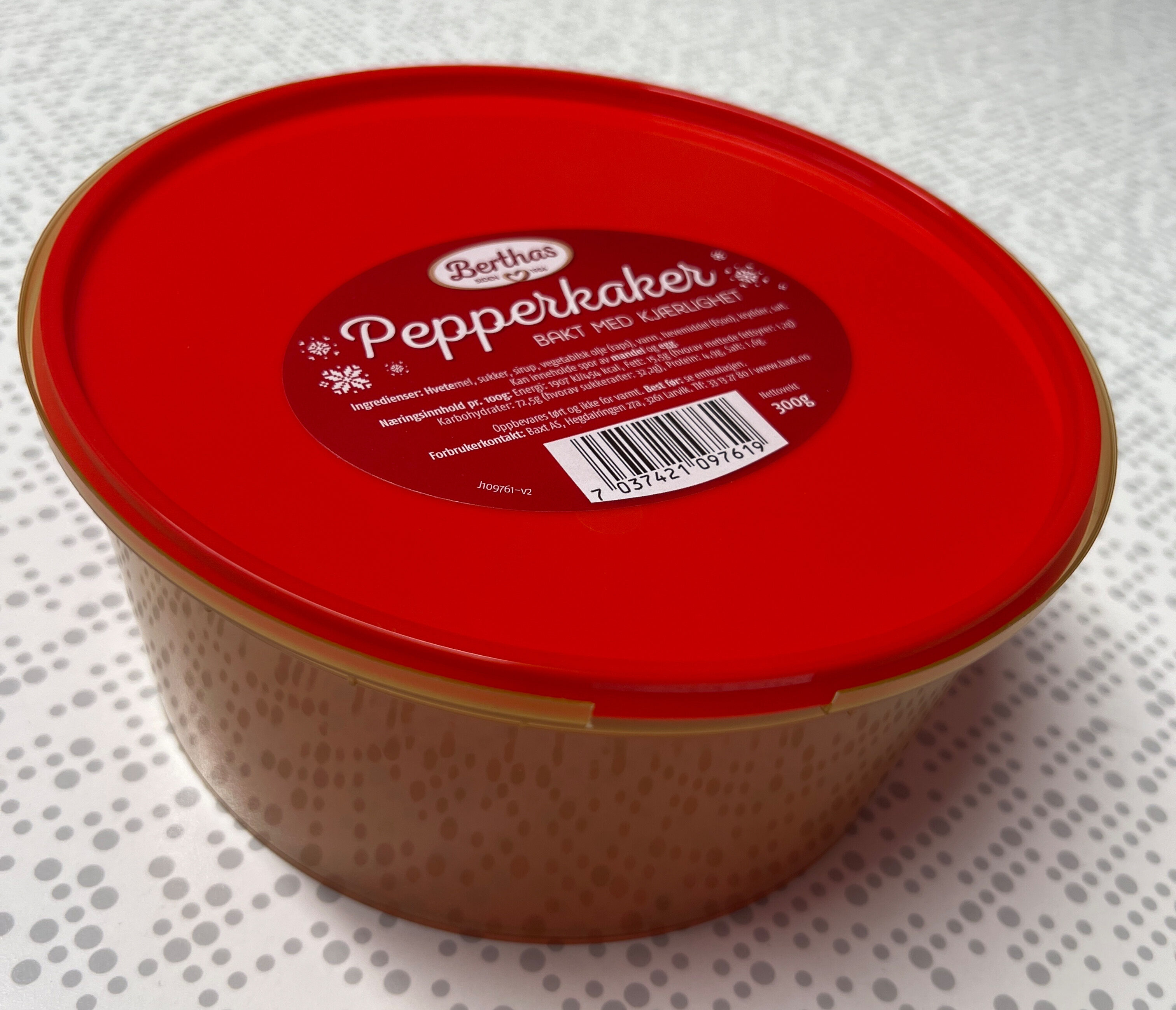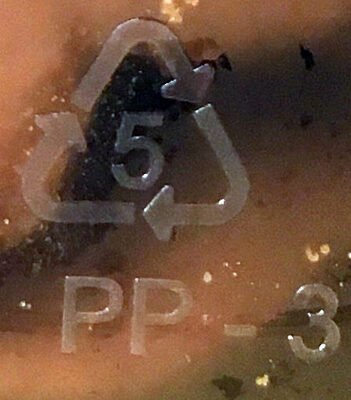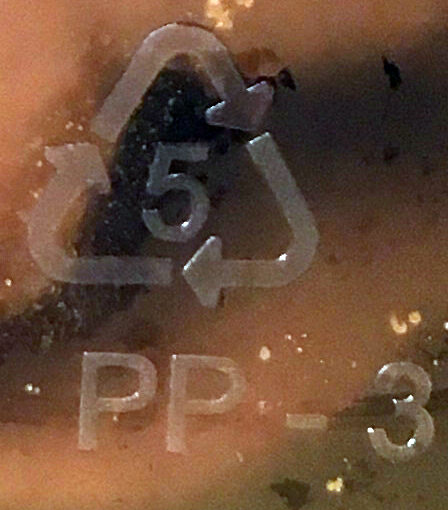Hjelp oss med å gjøre åpenhet om mat til det normale!
Som en ideell organisasjon, er vi avhengige av dine donasjoner for å fortsette å informere forbrukere verden over om hva de spiser.
Matrevolusjonen starter med deg!
Pepperkaker - Berthas - 300 gram
Pepperkaker - Berthas - 300 gram
Strekkode: 7037421097619 (EAN / EAN-13)
Mengde: 300 gram
Emballasje: 05 PP-3
Kategorier: en:Snacks, en:Sweet snacks, en:Biscuits and cakes, en:Gingerbreads
Ingrediensopprinnelse: Norge
Butikker: Coop Prix
Land hvor produktet selges: Norge
Samsvarer med dine preferanser
Helse
Ingredienser
-
10 ingredienser
Hvetemel, sukker, sirup, vegetabilsk olje (raps), vann, hevemiddel (E500), krydder, salt. Kan inneholde spor av mandel og egg.Allergener: GlutenSpor: Egg, Nøtter
Matprosessering
-
Bearbeidet mat
Elementer som indikerer at produkter er i en:3 - Processed foods-gruppen:
- Ingrediens: Salt
- Ingrediens: Sukker
- Ingrediens: Vegetabilsk olje
- Kategori: Sweet snacks
Matvarer er inndelt i 4 grupper i henhold til bearbeidingsgraden:
- Ubearbeidet eller minimalt bearbeidet mat
- Bearbeidede kulinariske ingredienser
- Bearbeidet mat
- Ultrabearbeidede matvarer
Bestemmelsen av gruppa er basert på kategorien til produktet og på ingrediensene den inneholder.
Tilsetningsstoffer
-
E500 - Natriumkarbonater
Sodium carbonate: Sodium carbonate, Na2CO3, -also known as washing soda, soda ash and soda crystals, and in the monohydrate form as crystal carbonate- is the water-soluble sodium salt of carbonic acid. It most commonly occurs as a crystalline decahydrate, which readily effloresces to form a white powder, the monohydrate. Pure sodium carbonate is a white, odorless powder that is hygroscopic -absorbs moisture from the air-. It has a strongly alkaline taste, and forms a moderately basic solution in water. Sodium carbonate is well known domestically for its everyday use as a water softener. Historically it was extracted from the ashes of plants growing in sodium-rich soils, such as vegetation from the Middle East, kelp from Scotland and seaweed from Spain. Because the ashes of these sodium-rich plants were noticeably different from ashes of timber -used to create potash-, they became known as "soda ash". It is synthetically produced in large quantities from salt -sodium chloride- and limestone by a method known as the Solvay process. The manufacture of glass is one of the most important uses of sodium carbonate. Sodium carbonate acts as a flux for silica, lowering the melting point of the mixture to something achievable without special materials. This "soda glass" is mildly water-soluble, so some calcium carbonate is added to the melt mixture to make the glass produced insoluble. This type of glass is known as soda lime glass: "soda" for the sodium carbonate and "lime" for the calcium carbonate. Soda lime glass has been the most common form of glass for centuries. Sodium carbonate is also used as a relatively strong base in various settings. For example, it is used as a pH regulator to maintain stable alkaline conditions necessary for the action of the majority of photographic film developing agents. It acts as an alkali because when dissolved in water, it dissociates into the weak acid: carbonic acid and the strong alkali: sodium hydroxide. This gives sodium carbonate in solution the ability to attack metals such as aluminium with the release of hydrogen gas.It is a common additive in swimming pools used to raise the pH which can be lowered by chlorine tablets and other additives which contain acids. In cooking, it is sometimes used in place of sodium hydroxide for lyeing, especially with German pretzels and lye rolls. These dishes are treated with a solution of an alkaline substance to change the pH of the surface of the food and improve browning. In taxidermy, sodium carbonate added to boiling water will remove flesh from the bones of animal carcasses for trophy mounting or educational display. In chemistry, it is often used as an electrolyte. Electrolytes are usually salt-based, and sodium carbonate acts as a very good conductor in the process of electrolysis. In addition, unlike chloride ions, which form chlorine gas, carbonate ions are not corrosive to the anodes. It is also used as a primary standard for acid-base titrations because it is solid and air-stable, making it easy to weigh accurately.Kilde: Wikipedia (Engelsk)
Analyse av ingredienser:
-
en:Palm oil free
Ingen ingredienser som inneholder palmeolje ble oppdaget
-
en:Vegan
Ingen ikke-veganske ingredienser funnet
-
en:Vegetarian
Ingen ikke-vegetarianske ingredienser funnet
-
Detaljer fra analysen av ingrediensene
nb: Hvetemel, sukker, sirup, vegetabilsk olje (raps), vann, hevemiddel (e500), krydder, salt- Hvetemel -> en:wheat-flour - vegan: yes - vegetarian: yes - ciqual_proxy_food_code: 9410 - percent_min: 12.5 - percent_max: 100
- sukker -> en:sugar - vegan: yes - vegetarian: yes - ciqual_proxy_food_code: 31016 - percent_min: 0 - percent_max: 32.2
- sirup -> en:syrup - vegan: yes - vegetarian: yes - percent_min: 0 - percent_max: 32.2
- vegetabilsk olje -> en:vegetable-oil - vegan: yes - vegetarian: yes - from_palm_oil: maybe - percent_min: 0 - percent_max: 25
- raps -> en:rapeseed - vegan: yes - vegetarian: yes - percent_min: 0 - percent_max: 25
- vann -> en:water - vegan: yes - vegetarian: yes - ciqual_food_code: 18066 - percent_min: 0 - percent_max: 20
- hevemiddel -> en:raising-agent - percent_min: 0 - percent_max: 16.6666666666667
- e500 -> en:e500 - vegan: yes - vegetarian: yes - percent_min: 0 - percent_max: 16.6666666666667
- krydder -> en:spice - vegan: yes - vegetarian: yes - percent_min: 0 - percent_max: 14.2857142857143
- salt -> en:salt - vegan: yes - vegetarian: yes - ciqual_food_code: 11058 - percent_min: 0 - percent_max: 1.6
Ernæring
-
Dårlig ernæringskvalitet
⚠ ️Advarsel: mengden fiberer ikke spesifisert, deres mulige positive bidrag til karakteren kunne ikke tas med i betraktningen.⚠ ️Advarsel: mengden frukt, grønnsaker og nøtter er ikke spesifisert på etiketten, den ble anslått utfra ingredienslista: 6Dette produktet regnes ikke som en drikke under beregningen av Nutri-Score.
Positive poeng: 0
- Protein: 3 / 5 (verdi: 4.9, avrundet verdi: 4.9)
- Fiber: 0 / 5 (verdi: 0, avrundet verdi: 0)
- Frukt, grønnsaker, nøtter, og raps/valnøtt/olivenoljer: 0 / 5 (verdi: 6.9125, avrundet verdi: 6.9)
Negative poeng: 20
- Energi: 5 / 10 (verdi: 1907, avrundet verdi: 1907)
- Sukker: 7 / 10 (verdi: 32.2, avrundet verdi: 32.2)
- Mettet fett: 1 / 10 (verdi: 1.2, avrundet verdi: 1.2)
- Natrium: 7 / 10 (verdi: 640, avrundet verdi: 640)
Poengene for proteiner telles ikke fordi de negative poengene er større eller lik 11.
Ernæringsverdi: (20 - 0)
Nutri-Score:
-
Næringsnivåer
-
Fett i moderat mengde (15.5%)
Fint å vite- Et høyt inntak av fett, spesielt mettet fett, kan øke kolesterolet, som øker risikoen for hjertesjukdommer.
Anbefaling: Reduser inntaket av fett og mettet fett- Velg produkter med lavere fett- og mettet fettinnhold.
-
Mettet fett i liten kvantitet (1.2%)
Fint å vite- Et høyt inntak av fett, spesielt mettet fett, kan øke kolesterolet, som øker risikoen for hjertesjukdommer.
Anbefaling: Reduser inntaket av fett og mettet fett- Velg produkter med lavere fett- og mettet fettinnhold.
-
Sukkerarter i høy kvantitet (32.2%)
Fint å vite- Et høyt inntak av sukker kan føre til økning i vekt og tannråte. Det øker også risikoen for diabetes type 2 og hjerte- og karsjukdommer.
Anbefaling: Begrens inntaket av sukker og sukkerholdige drikker- Sukkerholdige drikker (som brus, fruktdrikker, og fruktjuicer og nektar) burde begrenses så mye som mulig (ikke mer enn 1 glass om dagen).
- Velg produkter med lavt sukkerinnhold og reduser inntaket av produkter med tilsatt sukker.
-
Salt i høy kvantitet (1.6%)
Fint å vite- Et høyt inntak av salt (eller sodium) kan føre til et økt blodtrykk, som kan føre til høyere risiko for hjertesjukdom og slag.
- Mange folk har høyt blodtrykk uten å vite det, siden det ofte ikke er noen symptomer.
- De fleste inntar for mye salt (i gjennomsnitt 9 til 12 gram per dag), cirka det dobbelte av den anbefalte høyeste mengden av inntak.
Anbefaling: Begrens inntaket av salt og saltet mat- Reduser mengden salt som brukes ved matlaging, og ikke salt igjen ved bordet.
- Begrens inntaket av salte snacks og velg produkter med lavere saltinnhold.
-
-
Ernæringsinnhold
Ernæringsinnhold Som solgt
for 100 g / 100 mlSom solgt
per porsjon (25 gram)Sammenlignet med: en:Gingerbreads Energi 1 907 kj
(454 kcal)477 kj
(114 kcal)+3 % Fett 15,5 g 3,88 g −1 % Mettet fett 1,2 g 0,3 g −79 % Karbohydrat 72,5 g 18,1 g +7 % Sukkerarter 32,2 g 8,05 g −0 % Kostfiber ? ? Protein 4,9 g 1,23 g −14 % Salt 1,6 g 0,4 g +43 % Fruits‚ vegetables‚ nuts and rapeseed‚ walnut and olive oils (estimate from ingredients list analysis) 6,912 % 6,912 %
Miljø
-
Eco-Score A - Veldig lavt miljøavtrykk
Eco-Scoren er en eksperimentell poengsum som oppsummerer miljøavtrykket til matprodukter.→ Eco-Scoren ble opprinnelig utviklet for Frankrike og den blir nå utvidet til andre europeiske land. Eco-Score-formelen er i stadig endring og forbedres jevnlig for å gjøre den mer presis og bedre egnet til hvert land.Livssyklusanalyse
-
Gjennomsnittlig avtrykk for produkter i samme kategori: A (Score: 86/100)
Kategori: Gingerbread
Kategori: Gingerbread
- PEF-miljøscore: 0.23 (jo lavere poengsum, jo lavere avtrykk)
- inkludert innvirkning på klimaendringer: 1.69 kg CO2-ekv./kg produkt
Trinn Påvirkning Landbruk
69.3 %Bearbeiding
15.4 %Emballasje
8.1 %Transport
5.1 %Distribusjon
2.1 %Forbruk
0.0 %
Fordeler og ulemper
-
Opprinnelsene til ingredienser med lavt avtrykk
Fordel: +19
Miljøpolicy: +4
Transport: +15
Opprinnelsen til produktet og/eller dets ingredienser % av ingredienser Påvirkning Norge 100 %Lav
-
Emballasje med moderat avtrykk
Ulempe: -8
Form Material Resirkulering Påvirkning Unknown PP 5 - polypropen Høy ⚠ ️ Informasjonen om emballasjen til dette produktet er ikke tilstrekkelig presis (eksakte former og materialer av alle komponenter i emballasjen).⚠ ️ For en mer presis beregning av Eco-Scoren, kan du modifisere produktsiden og legge dem til.
Hvis du er produsenten av produktet, kan du sende oss informasjon gjennom vår gratis plattform for produsenter.
Eco-Score for dette produktet
-
Avtrykk for dette produktet: A (Score: 97/100)
Produkt: Pepperkaker - Berthas - 300 gram
Livssyklusanalysescore: 86
Sum av fordeler og ulemper: +11
Endelig poengsum: 97/100
-
Carbon footprint
-
Likt som å kjøre 0.9 km i en bensinbil
169 g CO² per 100g produkt
Karbonutslippstallet kommer fra ADEME's Agribalyse database, for kategorien: Gingerbread (Kilde: Ademe Agribalyse Database)
Trinn Påvirkning Landbruk
61.5 %Bearbeiding
11.8 %Emballasje
17.1 %Transport
8.5 %Distribusjon
1.2 %Forbruk
0.0 %
Emballasje
-
Emballasje med moderat avtrykk
-
Emballasjedeler
(PP 5 - polypropen)
-
Emballasjematerialer
Material % Emballasjevekt Emballasjevekt per 100 g produkt Plastic
-
Transport
-
Opprinnelsen til ingredienser
Opprinnelsene til ingredienser med lavt avtrykk
Opprinnelsen til produktet og/eller dets ingredienser % av ingredienser Påvirkning Norge 100 %Lav
Report a problem
-
Incomplete or incorrect information?
Category, labels, ingredients, allergens, nutritional information, photos etc.
If the information does not match the information on the packaging, please complete or correct it. Open Food Facts is a collaborative database, and every contribution is useful for all.
Datakilder
Produkt lagt til av foodvisor
Siste redigering av produktsiden den av ompopo.
Produktside også redigert av ecoscore-impact-estimator, inf, odinh, openfoodfacts-contributors, packbot.













